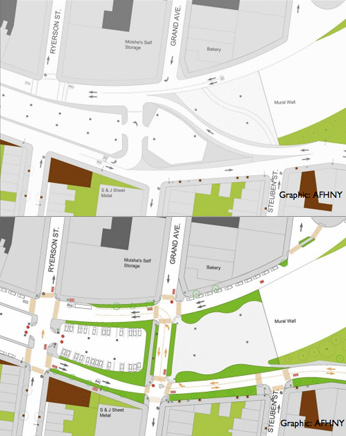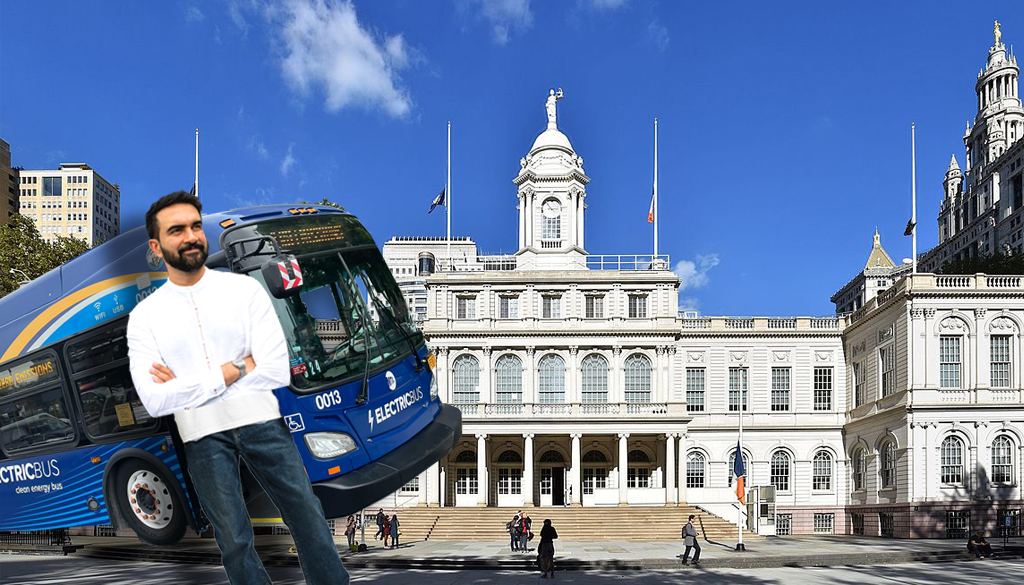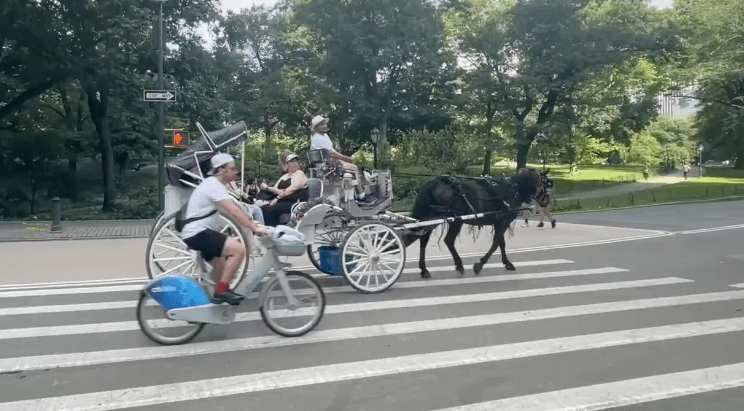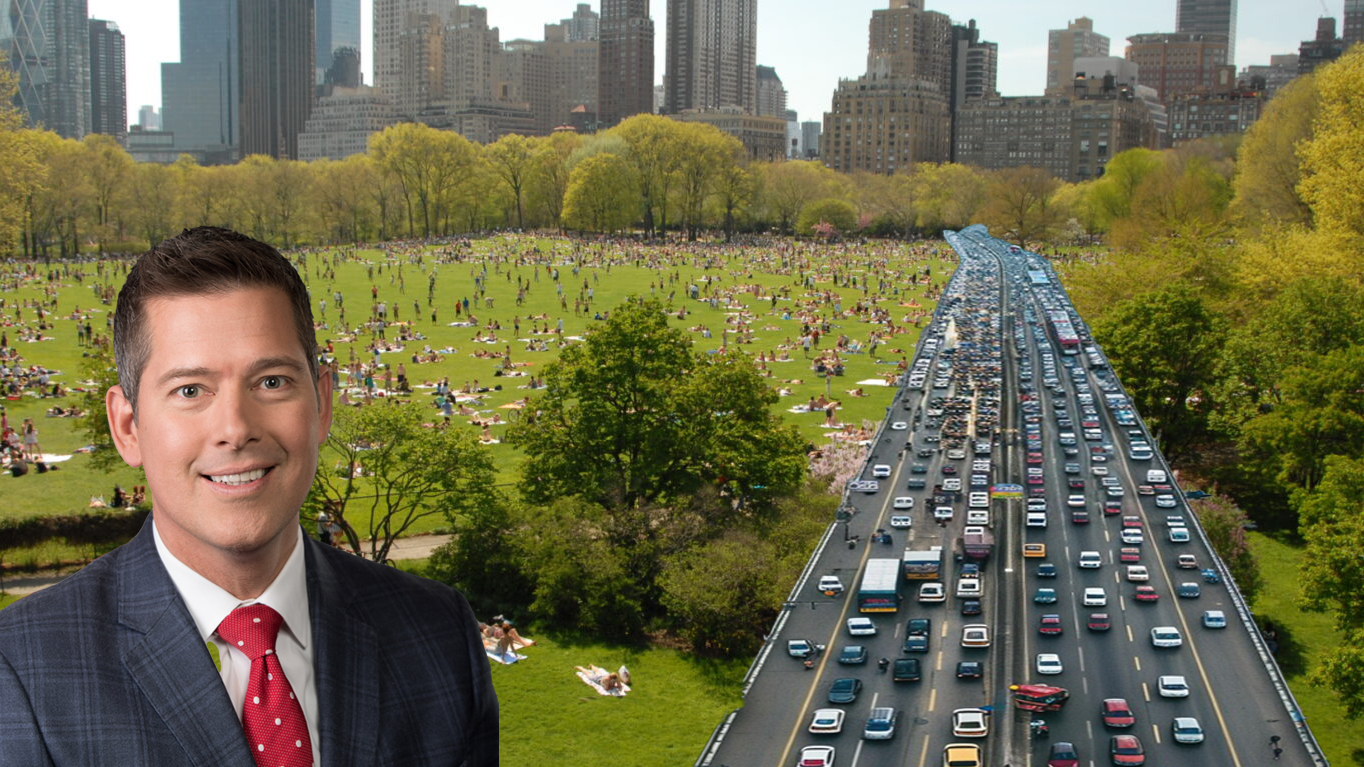In 1959, when the Brooklyn-Queens Expressway was under construction, Park Avenue in the Wallabout section of Fort Greene and Clinton Hill was converted from a neighborhood street to a service road that would run underneath the new elevated highway. Walking on the street hasn't been the same since. With 160,000 cars roaring by overhead each day, two lanes in each direction on the surface, and more than 300 parking spaces in the median, the street is not what you would call pedestrian-friendly. It's also dangerous, with a crash rate higher than three-quarters of Brooklyn streets.

More than 50 years after Robert Moses and the BQE changed Park Avenue, the Myrtle Avenue Revitalization Project Local Development Corporation (MARP) is pushing to enhance the street for walking and public activity, unveiling a slate of proposals to reduce speeding and improve pedestrian safety [PDF].
In 2009 and 2010, MARP hosted three community workshops as part of an effort to reuse spaces beneath the BQE. Based on community feedback at those events, the group decided to focus on traffic safety. In late 2010, Architecture for Humanity New York joined the project, working with MARP throughout 2011 to conduct research and host workshops. An advisory committee comprised of residents, community organizations and city agencies also helped guide the recommendations. Funding for the report was provided by the Brooklyn Community Foundation.
The recommendations are comprehensive and address everything from litter to traffic signal timing. In May, MARP went before Community Board 2's transportation committee, which voted unanimously to support the proposals.
Intersections would receive significant upgrades. The plan calls for neckdowns and crosswalk markings on cross-streets along the median. Access points to parking underneath the BQE would be marked as pedestrian crossings, with raised crosswalks and stop signs. At North Portland, Clinton and Clermont Avenues, the report recommends closing auto access to parking under the BQE to improve safety for the higher number of pedestrians crossing Park Avenue at those intersections.
Perhaps the knottiest location is at the eastern end of the corridor at "the Crossover," where the BQE bends north and westbound Park Avenue curves beneath the expressway. The absence of crosswalks and the highway ramp-like design of this location encourage speeding and make crossing difficult. In 2010, cyclist Stefanos Tsigrimanis was killed by a driver at this location. MARP's proposal would eliminate the crossover, directing westbound traffic on Park Avenue to cross under the BQE at Grand Avenue. This creates a large space underneath the BQE that could be used for community events or parking.
Traffic volumes on Park are low enough, the report says, to justify converting one of the two lanes in each direction to parallel parking outside of rush hour. Currently, parking is only allowed on the outside lanes of the corridor, but not along the median. Median-side parking would reduce speeding when traffic volumes are low. It is also less expensive than curb extensions and could be implemented almost immediately.

Additionally, the report recommends adding street trees to reduce speeding and provide greenery, daylighting intersections by removing parking (which would improve visibility for drivers and pedestrians), and adding bus bulbs for the four busiest bus stops on Park Avenue: eastbound at Carlton Avenue and westbound at Washington Avenue, Carlton Avenue and North Portland Street.
The report calls on NYPD to increase speeding enforcement, especially during hours with the highest pedestrian volumes. The 88th Precinct, which covers the entire Park Avenue study area, issued 29 speeding tickets in 2012 as of July. More than three times as many tickets were issued for tinted windows. In all of 2011, the precinct issued 42 speeding tickets. That's less than one a week.
Stormwater management is also a concern along the corridor. MARP is asking the New York State DOT to fix leaky drainage pipes from the BQE. Where the sidewalk is too narrow for street trees, the report proposes tree bump-outs that can handle stormwater runoff from the street. MARP has also partnered with planning and engineering firm AKRF on preliminary designs for a planter near Steuben Street that would collect runoff from the BQE drainage pipes.
"We’ve been communicating with various agencies throughout the process," said MARP Deputy Director Meredith Phillips Almeida in a statement, "but it is important that we continue to show there is broad-based community support for making these improvements as soon as possible."
MARP is presenting the plan at an event this afternoon featuring Transportation Alternatives, Council Member Letitia James and State Committee Member Lincoln Restler. Stay tuned for more coverage.





